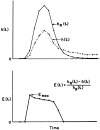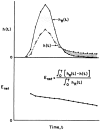Extraction of minerals after experimental fractures of the tibia in dogs
- PMID: 383718
- PMCID: PMC3625437
Extraction of minerals after experimental fractures of the tibia in dogs
Abstract
In a study of a standardized fracture of the tibia in dogs, we examined the relationship between extraction of strontium-85, as measured by a multiple indicator-dilution technique, and blood flow, as determined by an iodoantipyrine-washout technique. Although the blood flow at the fracture site increased from a control value of 1.5 milliliters per 100 grams of bone per minute to a value of 6.65 milliliters per 100 grams of bone per minute at two weeks, the maximum instantaneous extraction of 85Sr by the fractured tibiae did not change from a value of about 0.77 of the amount injected. These results suggest that the increase in blood flow is accomplished by recruitment of capillaries, that the permeabilities of the capillary beds in the fractured tibia and in the normal tibia are similar, and that the pattern of flow in the fractured tibia remains non-uniform. The increased capillary surface area available for exchange is suggested as the reason that strontium extraction was unchanged despite the increased flow.
Clinical Relevance: This study has shown that calcium is only moderately rapidly exchangeable across the capillary membrane and made available for uptake by osteoblasts and deposition in callus at the fracture site. Because calcium delivery via capillary is essential, and because capillary surface area is ordinarily increased in the region of a healing fracture, we can now see clearly that clinical treatment, in particular manipulative intervention, should be carried out in a fashion that minimizes damage to the capillary bed. The exchange processes described in this study are the same as those involved in the deposition of agents used for bone-scanning, and thus this information provides a basis for the timing of scanning studies and for their interpretation.
Figures








References
-
- Allen TH, Krzywicki HJ, Roberts JE. Density, Fat, Water and Solids in Freshly Isolated Tissues. J Appl Physiol. 1959;14:1005–1008. - PubMed
-
- Bassingthwaighte JB. The Measurement of Blood Flows and Volumes by Indicator Dilution. In: Ray CD, editor. Medical Engineering. Chapter 20. Chicago: Year Book Medical Publishers; 1973. pp. 246–260.
-
- Crone Christian. Does “Restricted Diffusion” Occur in Muscle Capillaries? Proc Soc Exper Biol and Med. 1963;112:453–455. - PubMed
Publication types
MeSH terms
Substances
Grants and funding
LinkOut - more resources
Full Text Sources
Research Materials

